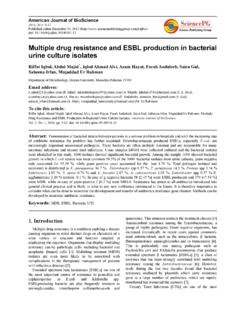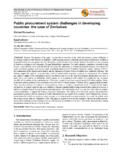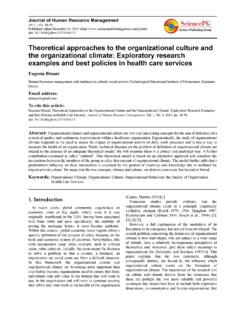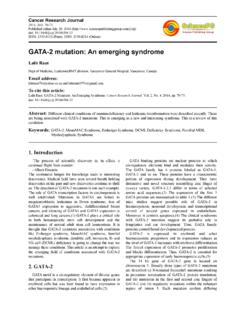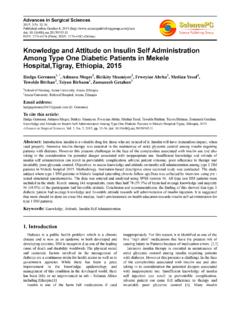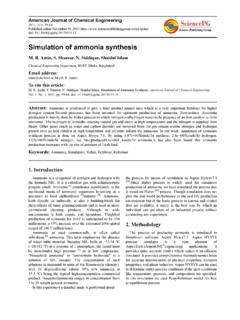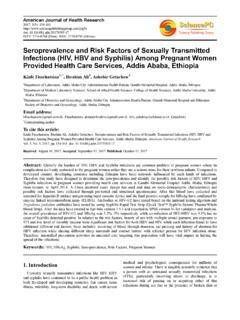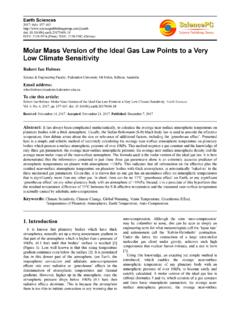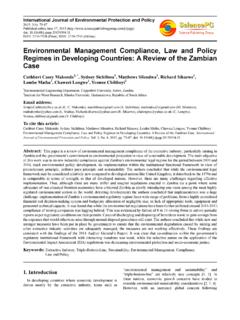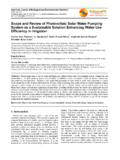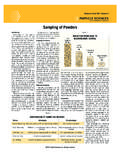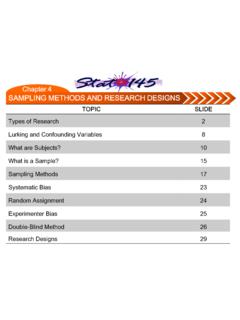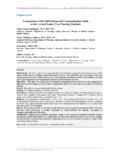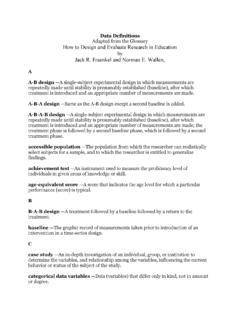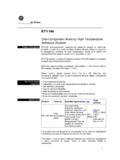Transcription of Comparison of Convenience Sampling and …
1 American Journal of Theoretical and Applied Statistics 2016; 5(1): 1-4 Published online December 22, 2015 ( ) doi: ISSN: 2326-8999 (Print); ISSN: 2326-9006 (Online) Comparison of Convenience Sampling and purposive Sampling Ilker Etikan, Sulaiman Abubakar Musa, Rukayya Sunusi Alkassim Department of Biostatistics, Near East University, Nicosia-TRNC, Cyprus Email address: (I. Etikan), (I. Etikan), (S. A. Musa), (R. S. Alkassim) To cite this article: Ilker Etikan, Sulaiman Abubakar Musa, Rukayya Sunusi Alkassim. Comparison of Convenience Sampling and purposive Sampling . American Journal of Theoretical and Applied Statistics. Vol. 5, No. 1, 2016, pp. 1-4. doi: Abstract: This article studied and compared the two nonprobability Sampling techniques namely, Convenience Sampling and purposive Sampling .
2 Convenience Sampling and purposive Sampling are Nonprobability Sampling Techniques that a researcher uses to choose a sample of subjects/units from a population. Although, Nonprobability Sampling has a lot of limitations due to the subjective nature in choosing the sample and thus it is not good representative of the population, but it is useful especially when randomization is impossible like when the population is very large. It can be useful when the researcher has limited resources, time and workforce. It can also be used when the research does not aim to generate results that will be used to create generalizations pertaining to the entire population. Therefore, there is a need to use nonprobability Sampling techniques.
3 The aim of this study is to compare among the two nonrandom Sampling techniques in order to know whether one technique is better or useful than the other. Different articles were reviewed to compare between Convenience Sampling and purposive Sampling and it is concluded that the choice of the techniques ( Convenience Sampling and purposive Sampling ) depends on the nature and type of the research. Keywords: Convenience Sampling , purposive Sampling , Sampling Techniques 1. Introduction Sample is a portion of a population or universe [20]. However, by population, many often consider to people only. Population does not necessarily mean a number of people [22]. It can also refer to total quantity of the things or cases which are the subject of our research.
4 Probability Sampling is defined as having the distinguishing characteristic that each unit in the population has a known, nonzero chance of being included in the sample [8]. It is described more clearly as every participant has an equal probability of being selected from the population [6]. In probability Sampling , each element in the population has a known nonzero chance of being selected through the use of a random selection procedure [1]. In nonprobability Sampling , randomization is not important in selecting a sample from the population of interest. Rather, subjective methods are used to decide which elements are included in the sample. Hence, nonprobability Sampling is a Sampling technique where the samples are gathered in a process that does not give all the participants or units in the population equal chances of being included.
5 Why would researcher consider using nonprobability Sampling ? In some situations, the population may not be well defined. In other situations, there may not be great concern in drawing inferences from the sample to the population. Perhaps, the most common reason for using nonprobability Sampling is that it is cheaper than probability Sampling and can often be implemented more quickly [1]. It is very crucial for a researcher to determine which non probability Sampling technique is applicable to his study. The technique to be used depends on the type, nature and purpose of the study. When subjects are chose because of the close proximity to a researcher, that is, the ones that are easier for the researcher to access, the researcher is making a Convenience Sampling .
6 But for purposive Sampling , a researcher has something in mind and participants that suit the purpose of the study are included. 2. Convenience Sampling In every type of research, it would be superlative to use the whole population, but in most cases, it is not possible to 2 Ilker Etikan et al.: Comparison of Convenience Sampling and purposive Sampling . include every subject because the population is almost finite. This is the rationale behind using Sampling techniques like Convenience Sampling by most researchers [5]. Convenience Sampling (also known as Haphazard Sampling or Accidental Sampling ) is a type of nonprobability or nonrandom Sampling where members of the target population that meet certain practical criteria, such as easy accessibility, geographical proximity, availability at a given time, or the willingness to participate are included for the purpose of the study [4].
7 It is also referred to the researching subjects of the population that are easily accessible to the researcher [18]. Convenience samples are sometimes regarded as accidental samples because elements may be selected in the sample simply as they just happen to be situated, spatially or administratively, near to where the researcher is conducting the data collection. Ecological data are often taken using Convenience Sampling , here data are collected along roads, trails or utility corridors and hence are not representative of population of interest. Other example of Convenience Sampling include data taken subjectively near camp, around parking areas, or an areas where density is known to be high.
8 Biologist often use Convenience Sampling in the field work because it is easier like walking on a road and stop occasionally to record numbers. With numbers derive from Convenience Sampling , one can make only weak statement about some characteristic of the sample itself rather than a formal inductive inference concerning the population of interest. Further explains that, captive participants such as students in the researcher s own institution are main examples of Convenience Sampling [4]. Convenience Sampling is affordable, easy and the subjects are readily available. It is compulsory for the researcher to describe how the sample would differ from the one that was randomly selected. It is also necessary to describe the subjects who might be excluded during the selection process or the subjects who are overrepresented in the sample [5].
9 The main objective of Convenience Sampling is to collect information from participants who are easily accessible to the researcher like recruiting providers attending a staff meeting for study participation. Although commonly used, it is neither purposeful nor strategic [11]. The main assumption associated with Convenience Sampling is that the members of the target population are homogeneous. That is, that there would be no difference in the research results obtained from a random sample, a nearby sample, a co-operative sample, or a sample gathered in some inaccessible part of the population [10]. Point out that the obvious disadvantage of Convenience Sampling is that it is likely to be biased [13].
10 They advise researchers that the Convenience Sampling should not be taken to be representative of the population. Still, there is another problem of great concern related to Convenience Sampling , the problem of outliers. Because of the high self-selection possibility in non-probability Sampling , the effect of outliers can be more devastating in this kind of subject selection. Outliers are cases whom consider as not belonging to the data. In a Convenience sample, on the contrary, neither biases nor their probabilities are quantified [7]. In fact, the researcher does not know how well a Convenience sample will represent the population regarding the traits or mechanism under research.
